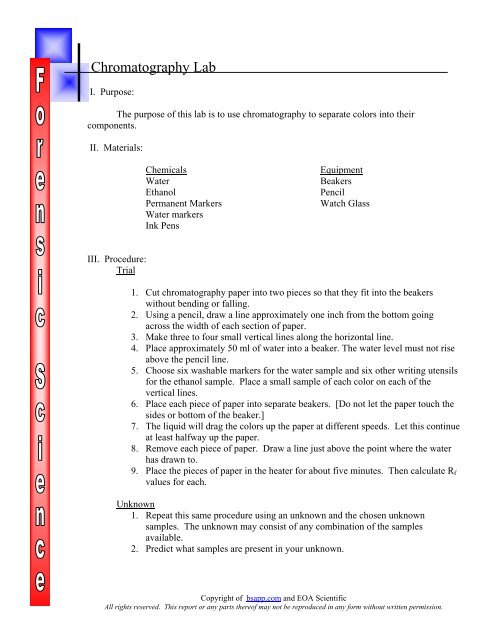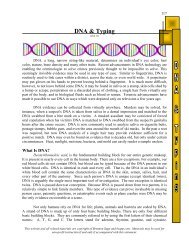Chromatography Lab Report
Chromatography Lab Report
Chromatography Lab Report
Create successful ePaper yourself
Turn your PDF publications into a flip-book with our unique Google optimized e-Paper software.
<strong>Chromatography</strong> <strong>Lab</strong><br />
I. Purpose:<br />
The purpose of this lab is to use chromatography to separate colors into their<br />
components.<br />
II. Materials:<br />
Chemicals<br />
Water<br />
Ethanol<br />
Permanent Markers<br />
Water markers<br />
Ink Pens<br />
Equipment<br />
Beakers<br />
Pencil<br />
Watch Glass<br />
III. Procedure:<br />
Trial<br />
1. Cut chromatography paper into two pieces so that they fit into the beakers<br />
without bending or falling.<br />
2. Using a pencil, draw a line approximately one inch from the bottom going<br />
across the width of each section of paper.<br />
3. Make three to four small vertical lines along the horizontal line.<br />
4. Place approximately 50 ml of water into a beaker. The water level must not rise<br />
above the pencil line.<br />
5. Choose six washable markers for the water sample and six other writing utensils<br />
for the ethanol sample. Place a small sample of each color on each of the<br />
vertical lines.<br />
6. Place each piece of paper into separate beakers. [Do not let the paper touch the<br />
sides or bottom of the beaker.]<br />
7. The liquid will drag the colors up the paper at different speeds. Let this continue<br />
at least halfway up the paper.<br />
8. Remove each piece of paper. Draw a line just above the point where the water<br />
has drawn to.<br />
9. Place the pieces of paper in the heater for about five minutes. Then calculate R f<br />
values for each.<br />
Unknown<br />
1. Repeat this same procedure using an unknown and the chosen unknown<br />
samples. The unknown may consist of any combination of the samples<br />
available.<br />
2. Predict what samples are present in your unknown.<br />
Copyright of bsapp.com and EOA Scientific<br />
All rights reserved. This report or any parts thereof may not be reproduced in any form without written permission.
IV. Observations:<br />
Trial:<br />
Unknown:<br />
Copyright of bsapp.com and EOA Scientific<br />
All rights reserved. This report or any parts thereof may not be reproduced in any form without written permission.
V. Data Table<br />
Trial:<br />
Writing Utensil Component Colors Rf Values<br />
Unknown:<br />
Writing Utensil Component Colors Rf Values<br />
VI.<br />
Sample Calculation<br />
Copyright of bsapp.com and EOA Scientific<br />
All rights reserved. This report or any parts thereof may not be reproduced in any form without written permission.
VII. Conclusion:<br />
What did you learn?<br />
What would you do different if you had the chance to do this lab over?/What<br />
warnings would you give someone else who has to do this lab?<br />
Where is this kind of lab, data, and/or experiment used in the real world?<br />
Copyright of bsapp.com and EOA Scientific<br />
All rights reserved. This report or any parts thereof may not be reproduced in any form without written permission.







